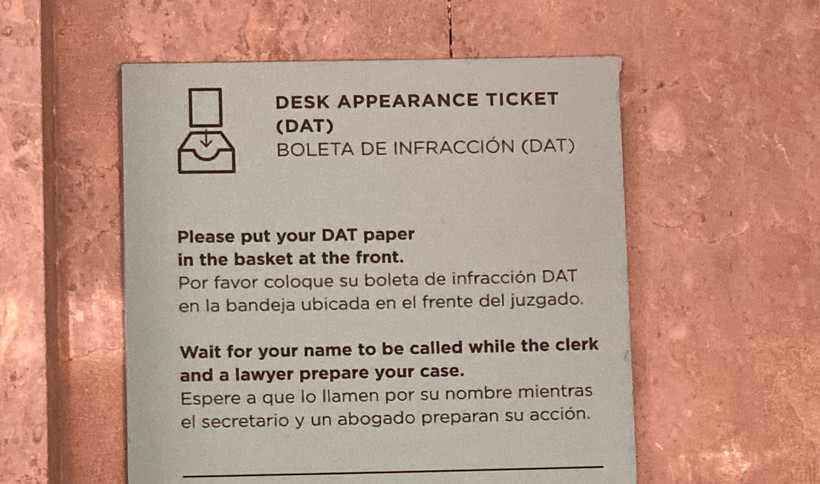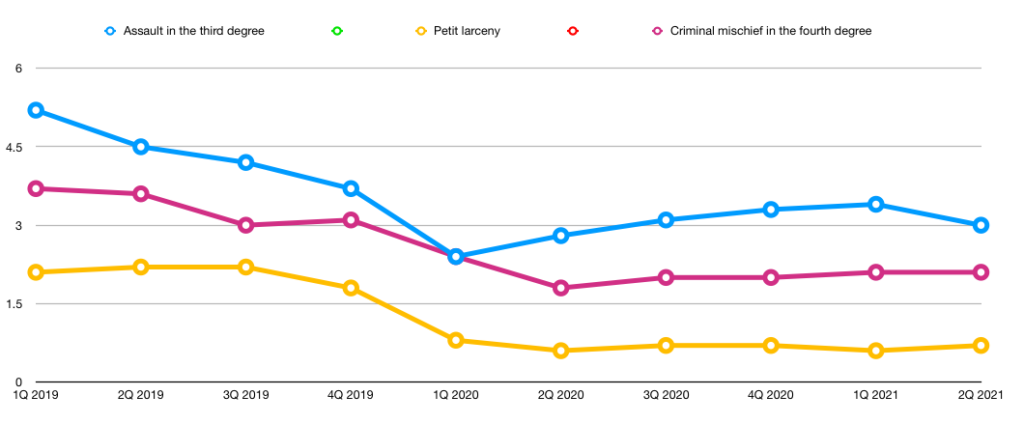Crucial Evidence Goes Stale As Desk Appearance Tickets Are Issued For More Serious Crimes, Leaving Defendants In Purgatory
Defendants given desk appearance tickets may not be assigned a public defender until 20 days after their arrest. That means crucial evidence in cases involving possible jail time could go missing.

Last month, on the first floor of 100 Centre Street in lower Manhattan, in New York City’s Criminal Court, a man sat on the wooden bench outside of the room labeled as “AR2” — arraignment court.
He shook his head. “I didn’t do anything,” he said. “I haven’t done a thing in my life.”
The 65-year-old man, who asked New York Focus not to use his name because of his ongoing criminal case, was arrested in late December in Penn Station and charged with petit larceny and possession of stolen property. But instead of being taken to Central Booking and then arraigned within twenty-four hours, like many crimes subject to serious jail time in New York City, he was given a Desk Appearance Ticket and told to come to court twenty days later.
Since then, he said, he’s been suspended from his job because of the open criminal case.
“I can’t pay bills, I can’t eat, I can’t pay rent,” he said. “Nothing.”
He wants to resolve the case quickly, because he needs to get back to work. But there’s little chance for a quick resolution of the case. Until the morning of his arraignment on January 17th, he had not even been assigned a lawyer — despite being arrested nearly a month before. During the arraignment hearing, the judge set another hearing for March, but after pushback from his public defender, they moved it up to February 15th — still a month after the arraignment.
“It’s you against them, and I can’t do nothing,” he said, before hobbling out of the courthouse on a knee that was recently replaced.
He’s one of the hundreds of defendants given Desk Appearance Tickets, charged with weighty crimes, watching as crucial evidence possibly goes stale before they get an appearance in court. And while criminal justice reform advocates have cheered changes that have kept people out of the city’s jails, they’re worried that without counsel being assigned quickly, people are needlessly losing their jobs—or their cases.
Public defenders say the solution is simple: the state court system should share with them the contact information of defendants after their arrest, rather than at arraignment, so that defenders can find evidence before it disappears. But court administrators say the twenty days between arrest and arraignment, in DAT cases, is too brief a period for that to be feasible.
A Surge in DATs
Desk Appearance Tickets (DATs) have long been a part of the criminal justice system in New York City. They offer an alternative to the “custodial arrest,” which usually involves spending up to twenty-four hours in custody, going through a borough’s “Central Booking” facility, and receiving an immediate decision from a judge on whether the defendant will be released or sent to Rikers Island.
With DATs, people arrested by the NYPD are released at the site of the arrest or shortly afterwards from a police precinct. They never have to go to Central Booking or spend time in jail. Instead, they’re told to report to an arraignment hearing twenty days after the arrest.
For decades, thousands of DATs were handed out each year for low-level offenses such as fare evasion and marijuana possession. Those offenses could have serious collateral consequences, but people receiving DATs for them rarely ended up in jail or prison.
Police officers also had the option to issue DATs for other misdemeanors and even low-level felonies, but they rarely took advantage of it. Charges like petit larceny and assault usually led to custodial arrest and an immediate arraignment hearing. Since these charges were also bail-eligible, judges could set monetary bail and hold those defendants unable to pay in Rikers before trial.
That began to change in 2020, after the state legislature passed criminal justice reforms aimed to reduce the state’s jail population. The reforms made DATs, rather than custodial arrests, the default response to misdemeanors and low-level felonies, and mandated that officers give DATs to people charged with offenses like petit larceny, criminal mischief in the fourth degree, and assault in the third degree. (Other offenses, like those involving weapons or domestic abuse, remained ineligible for a DAT.)
 Rate of custodial arrests as compared to DATs for three leading DAT eligible offenses. Source: NYPD
Rate of custodial arrests as compared to DATs for three leading DAT eligible offenses. Source: NYPDAfter the reform laws went into effect in January 2020, officers began handing out many more DATs for offenses that were bail-eligible before the reforms.
About one in three people arrested for third-degree assault in January 2020 were given a DAT, for example—up from one out of six in January 2019. And most people arrested for petit larceny in January 2020 were given DATs; a year earlier, two-thirds of them had been taken into custody.
Delayed Justice
The increase in DATs has largely been welcomed by public defenders and criminal justice reform advocates, who are looking to spare people from the possibility of jail.
But it has also presented a downside for defense attorneys: the twenty days between arrest and arraignment.
Public defenders are only assigned to clients at arraignments, meaning that defendants given DATs will not be assigned a public defender until 20 days after their arrest.
That means crucial evidence in cases involving possible jail time could go missing, or be destroyed, before defense investigators ever get a chance to track them down.
“The more time that passes, you are at a disadvantage because you're working backwards trying to locate someone,” said Bruni Marrero, the Director of Investigative Services at Legal Aid.
“Time passing from the time of the incident, to the time of arraignment, makes an investigator always feel under the gun, because you start thinking about a client who's waiting for that arraignment, when it could have already cost them a job,” he added.
Marrero oversees Legal Aid’s sixty-five investigators across the five boroughs, who are each responsible for between 150 and 300 cases at any given time. In general, the kinds of misdemeanor charges and low-level felonies that result in DATs, such as petit larceny and third-degree assault, are the easiest cases for investigators, since they typically only require evidence like the recovery of video surveillance from a store or contacting possible eye-witnesses of a minor scuffle. (Investigations for more serious charges often require obtaining evidence and information that, initially, only the prosecution has access to).
But that evidence becomes far harder to obtain as time passes. Within twenty days, for example, many video surveillance systems begin to overwrite old video to save money on memory storage.
"Because of the passage of time, those become the difficult ones,” Marrero said.
“Witnesses disappear, people move, and there’s no video. And these are cases that carry with them both significant collateral consequences for just being arrested — you can lose your job, jeopardize your immigration status — and can also carry serious jail time,” said Elizabeth Fischer, an attorney with Neighborhood Defender Services in Harlem.
This twenty-day delay between an arrest and arraignment often leaves defendants in purgatory, defense attorneys say. Cases that could be resolved quickly, even before arraignment — if an investigator secures exonerating footage, for example — have to continue to that first court date, and often beyond.
The delay is especially galling for defense attorneys, especially since many cases end up getting dismissed.
Since November 2020, the majority of cases resolved in New York City courts since November 2020 have resulted in either an Adjudication in Contemplation of Dismissal (ACD) or outright dismissal. (An ACD seals a case within six months if a defendant isn’t re-arrested). On a recent morning in Manhattan criminal court, half of the cases heard resulted in an ACD.
Some of the five borough’s District Attorneys use those twenty days to encourage people who have been given DATs to pursue diversion programs, in an attempt to resolve the case before arraignment.
In Brooklyn, District Attorney Eric Gonzalez has his office reach out to some people who receive DATs shortly after arrest. They offer them diversion programs like Project Reset and Brooklyn CLEAR, which guides people through conflict resolution or diversion programs. Although the practice has been limited by COVID-19, the Brooklyn DA’s office told New York Focus that it was able to reach 1,391 people pre-arraignment, and that over 400 people completed the programs in 2021.
“The most challenging part of this process has been making contact with people, because they don’t always leave good contact information with the police,” said a spokesperson for the Brooklyn District Attorney’s office.
“The Solution Is So, So, Easy”
Many defense attorneys believe the delays in investigations could easily be solved by assigning public defenders to cases and sharing clients’ contact information with those attorneys shortly after an arrest, rather than waiting until the arraignment hearing.
The 2019 reform law required the Office of Courts Administration (OCA) to collect contact information related to DATs. Defense attorneys believe that OCA should share that contact information well before an arraignment, much like it does for prosecutors who wish to offer diversion programs.
This wouldn’t be unprecedented; in fact, the courts system was sharing that contact information with attorneys earlier this year, when the pandemic-related Executive Order 202 allowed for courts to delay arraignments for DATs well past the usual twenty-day limit. That practice ended when the emergency order was lifted in June 2021.
“The solution is so, so easy,” Fischer said. “If the court would just provide that to us when they get it, we could reach out to clients, let them know they’re represented and get started working right away. We know the system works, because we just did it.”
Asked why the practice couldn’t continue past this June, an OCA spokesperson told New York Focus that the early sharing of contact information had been a side effect of pandemic-induced delays to arraignments. While Executive Order 202 was in effect, the spokesperson said, DAT arraignments were being pushed out for months and months, which gave OCA the opportunity to share the information well before court appearances, but not immediately after arrest.
But now that the twenty-day limit is back in effect, “there is no time to do so,” the spokesperson said.
Prosecutors might also have balked at another feature of assigning counsel pre-arraignment — defense lawyers can issue subpoenas in the case as soon as they’re assigned, sometimes obtaining crucial evidence before the prosecution has a chance to review it.
For defense investigators, the missed opportunities on these “minor” cases can weigh heavy.
“Give us the information as soon as you have it,” Bruni said. “That's all we ask. Every single investigator awaits that case assignment.”


